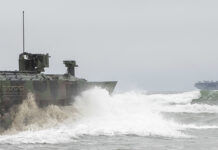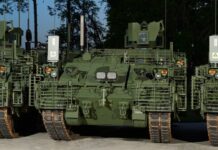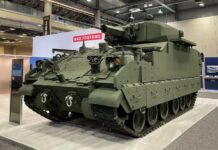The UK, Italy and Japan have announced that they will join forces, combining their future fighter efforts under the new Global Combat Air Programme (GCAP). On 9 December 2022, a joint statement from the UK PM Rishi Sunak, Italian PM Giorgia Meloni and Japanese PM Fumio Kishida, announced the launch of GCAP, “an ambitious endeavour to develop a next-generation fighter aircraft by 2035,” as a next step in their deepening trilateral partnership.
With this joint statement, the three nations have agreed to merge the sixth-generation Tempest manned platform of the UK/Italian Future Combat Air Systems (FCAS) programme, and Japan’s F-X fighter programme to replace their fleet of MHI F-2 multirole fighter aircraft by 2035. The FCAS programme was launched by the UK in 2018 as part of the Combat Air Strategy to replace the capabilities today provided by the Eurofighter Typhoon, and was joined by Italy with a Statement of Intent in September 2019 for the same purpose. Both the FCAS and F-X programmes include plans for the sixth-generation platform to be developed and operated alongside a fleet of unmanned aerial vehicles (UAVs). All the three nations are key users and partners in the fifth-generation Lockheed Martin F-35 programme, which the new aircraft will work alongside.

Credit: UK MoD
The merging of the UK-Italian Tempest programme, and Japan’s F-X fighter programme into GCAP represents an historic cooperation between European countries and Japan. Considering the close relationships and alliance between US and Japan in the post-war period, the fact that the Indo-Pacific power decided to form a partnership with European countries for a major national defence project, represents a key development in the political and industrial global relationships of Japan.
“By working together in a spirit of equal partnership, we are sharing the costs and the benefits of this investment in our people and technologies,” the three nations’ leaders underlined in their statement. The GCAP will therefore see a partnership of equals, with BAE Systems heading the development for the UK, Leonardo for Italy and Mitsubishi Heavy Industries (MHI) for Japan.
A key aspect that the joint statement unveiled about GCAP is the interoperability of the sixth-generation platform. “This programme has been designed with our Allies and partners at its very heart. Future interoperability with the United States, with NATO and with our partners across Europe, the Indo-Pacific and globally – is reflected in the name we have chosen for our programme. This concept will be at the centre of its development”, the three leaders said. Moreover, they share ambition for this aircraft “to be the centrepiece of a wider combat air system that will function across multiple domains”, they added.

Credit: BAE Systems
GCAP is open to other potential international partnerships, but while the UK-led FCAS also involved Sweden with a Memorandum of Understanding signed in July 2019, the country was not mentioned in this latest announcement. The Swedish Government and Saab so far have not provided any official comment following the trilateral joint statement.
The UK, Italy and Japan will now work intensively to establish the core platform concept and set up the structures in order to be “ready to launch the development phase in 2024”, according to the UK MoD. However, the current Tempest programme has been indicating that this phase would begin in 2025.
Ahead of the development phase, partners will also agree the cost-sharing arrangements based on a joint assessment of costs and national budget, highlighted the UK MoD immediately after the three nation’s leaders announcement. The Italian MoD hasn’t elaborated on GCAP after the joint announcement while the Japanese MoD provided a pre-announcement press briefing on December 8, held by an official from Japan’s Acquisition, Technology & Logistics Agency (ATLA).
GCAP’s activities will be focused on developing manned future combat aircraft. Additionally, a UK Government state noted that “alongside the development of the core future combat aircraft with Italy and Japan, the UK will assess our needs on any additional capabilities, for example weapons and uncrewed air vehicles”.
Interestingly, a joint statement dated 8 December, between the US Department of Defense and Japanese MoD on cooperation for the Japan’s Next Fighter Aircraft, was released by Japan’s Ministry of Foreign Affairs together with the trilateral joint statement announcing GCAP on 9 December. The US-Japanese statement refers to the support which US will provide “to Japan’s security and defense cooperation with likeminded allies and partners, including with the United Kingdom and Italy – two close partners of both of our countries – on the development of its next fighter aircraft”. The same statement, speaking about defence cooperation between the US and Japan also said “together, we have begun important collaboration through a series of discussions on autonomous systems capabilities, which could complement Japan’s next fighter program among other platforms. In this context, both sides have concurred to start concrete cooperation within the next year.”

Credit: BAE Systems
According to the timeline laid out by the Tempest programme, the sixth-generation platform was due to take to the skies by 2035, with initial operational capability (IOC) to be reached in 2040. However, no such information has been released regarding GCAP’s planned timeline. The manned fighter for the will continue to be named Tempest for the UK, according to the UK MoD. Italy has not yet revealed their chosen name, and Japan likewise hasn’t indicated if the F-X will become the F3 as originally intended.
The key aspects of convergence between the two programmes are the high costs and time for the development of a new combat aircraft which cannot be afforded by a single country, as well as the timeline of both projects, in addition to the European and Japan’s specific political and industrial environments. The European aerospace industry skipped the development of a fifth-generation, with leaders deciding to procure the US F-35. This resulted in the emergence of two competing programmes which: the Franco-German-Spanish FCAS (Future Combat Air System)/SCAF (Système de combat aérien du futur)/FCAS (Futuro Sistema Aéreo de Combate) and the UK-Italian FCAS. The latter in particular had limited possibilities to find additional partners with solid aerospace experience, except for Sweden.
In addition to the timelines of FCAS and F-X being aligned, which was indicated as a key factor for Japan’s decision toward the UK-Italian FCAS programme instead of the collaboration with the US’ Lockheed Martin, the requirements set by both programmes were also aligned, according to Japanese sources. However, more important was the possibility of sharing and managing confidential information such as the source code for upgrading various systems, or the introduction of new capabilities during the entire life cycle. The US Government and industry have, according to Japanese sources, refused to share such rights in previous programmes, such as the F-2 and the F-15.
The merging of Tempest with the F-X came about four and a half months after the UK MoD announced a three-country concept analysis at the Farnborough Air Show in mid-July. However, the activities between the respective Governments, MoDs and industries have been in progress since 2019. Since then, various important milestones in the cooperation between the three were reached. In December 2021, the Japanese and UK MoDs announced plans to jointly develop a future fighter aircraft engine demonstrator programme involving Rolls-Royce and IHI, to start early in 2022, alongside a memorandum of cooperation to enable future development opportunities. In July 2022, Leonardo UK and Japan’s Mitsubishi agreed on the concept of a radar technology demonstrator called Jaguar, first unveiled in February of the same year, following the completion of joint concept work and feasibility studies earlier in 2022. During the Farnborough air show 2022, Leonardo and BAE Systems announced they were actively progressing UK-Italian collaboration opportunities on the demonstrator aircraft as part of FCAS. According to the same statement, there was an agreement between Leonardo’s Italian and UK electronics businesses and Elettronica related to demonstration activities on advanced sensors and systems.

The Tempest project primarily involves key industrial partners BAE Systems, Leonardo UK, MBDA UK and Rolls-Royce, but according to a statement by UK Secretary of State for Defence, Ben Wallace, released alongside the joint announcement, the programme is delivering an uplift in skilled jobs for all three partner nations. The enterprise already employs over 2,500 highly skilled personnel in the UK alone, including engineers and programmers, with recruitment expanding rapidly.
In Italy, the industrial team led by Leonardo – which had been present in the programme since 2018 with Leonardo UK – will see the involvement of Avio Aero, Elettronica and MBDA Italia together with the entire innovative and productive national ecosystem, including Universities, Research Centres and small-medium enterprises (SMEs).
In Japan, the F-X programme, is led by the Acquisition, Technology & Logistic Agency (ATLA) with MHI selected as prime contractor. Partner companies also include IHI Corporation, Kawasaki Heavy Industries (KHI), Subaru, Toshiba Infrastructure Systems & Solutions, NEC, Fujitsu, and Mitsubishi Electric (Melco). According to MHI, the company has developed cutting-edge technologies for fighter through diverse research initiatives, including the X-2, an advanced technology demonstrator jet. “Since October 2020, when a contract was concluded with the Ministry of Defense on development of the future fighter aircraft (F-X), MHI has conducted a conceptual design and other development-related work. Simultaneously, MHI has been looking into the feasibility of collaboration with the UK and Italian defense industries under the leadership of the Government of the three nations”, the MHI statement said.
Luca Peruzzi












